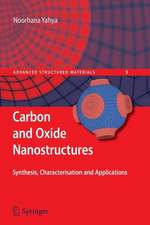Optical Sensors: Industrial Environmental and Diagnostic Applications: Springer Series on Chemical Sensors and Biosensors, cartea 1
Editat de Ramaier Narayanaswamy, Otto S. Wolfbeisen Limba Engleză Hardback – 12 noi 2003
| Toate formatele și edițiile | Preț | Express |
|---|---|---|
| Paperback (1) | 796.86 lei 38-44 zile | |
| Springer Berlin, Heidelberg – 15 dec 2010 | 796.86 lei 38-44 zile | |
| Hardback (1) | 956.03 lei 6-8 săpt. | |
| Springer Berlin, Heidelberg – 12 noi 2003 | 956.03 lei 6-8 săpt. |
Din seria Springer Series on Chemical Sensors and Biosensors
- 9%
 Preț: 1108.89 lei
Preț: 1108.89 lei - 18%
 Preț: 2098.81 lei
Preț: 2098.81 lei - 18%
 Preț: 1817.85 lei
Preț: 1817.85 lei - 18%
 Preț: 1216.16 lei
Preț: 1216.16 lei - 18%
 Preț: 1216.02 lei
Preț: 1216.02 lei - 18%
 Preț: 1822.57 lei
Preț: 1822.57 lei - 24%
 Preț: 1045.39 lei
Preț: 1045.39 lei - 18%
 Preț: 2484.74 lei
Preț: 2484.74 lei - 18%
 Preț: 2476.54 lei
Preț: 2476.54 lei - 18%
 Preț: 954.77 lei
Preț: 954.77 lei - 18%
 Preț: 955.08 lei
Preț: 955.08 lei - 15%
 Preț: 639.69 lei
Preț: 639.69 lei - 18%
 Preț: 1826.20 lei
Preț: 1826.20 lei - 15%
 Preț: 696.35 lei
Preț: 696.35 lei - 24%
 Preț: 781.37 lei
Preț: 781.37 lei - 18%
 Preț: 1217.90 lei
Preț: 1217.90 lei - 5%
 Preț: 1097.54 lei
Preț: 1097.54 lei
Preț: 956.03 lei
Preț vechi: 1165.88 lei
-18% Nou
Puncte Express: 1434
Preț estimativ în valută:
182.96€ • 198.67$ • 153.68£
182.96€ • 198.67$ • 153.68£
Carte tipărită la comandă
Livrare economică 23 aprilie-07 mai
Preluare comenzi: 021 569.72.76
Specificații
ISBN-13: 9783540408864
ISBN-10: 354040886X
Pagini: 448
Ilustrații: XX, 423 p. 281 illus., 55 illus. in color.
Dimensiuni: 155 x 235 x 33 mm
Greutate: 0.75 kg
Ediția:2004
Editura: Springer Berlin, Heidelberg
Colecția Springer
Seria Springer Series on Chemical Sensors and Biosensors
Locul publicării:Berlin, Heidelberg, Germany
ISBN-10: 354040886X
Pagini: 448
Ilustrații: XX, 423 p. 281 illus., 55 illus. in color.
Dimensiuni: 155 x 235 x 33 mm
Greutate: 0.75 kg
Ediția:2004
Editura: Springer Berlin, Heidelberg
Colecția Springer
Seria Springer Series on Chemical Sensors and Biosensors
Locul publicării:Berlin, Heidelberg, Germany
Public țintă
ResearchCuprins
1 Optical Technology until the Year 2000: An Historical Overview.- 2 Molecularly Imprinted Polymers for Optical Sensing Devices.- 3 Chromogenic and Fluorogenic Reactands: New Indicator Dyes for Monitoring Amines, Alcohols and Aldehydes.- 4 Design, Quality Control and Normalization of Biosensor Chips.- 5 Rapid, Multiplex Optical Biodetection for Point-of-Care Applications.- 6 Multi-functional Biochip for Medical Diagnostics and Pathogen Detection.- 7 Surface Plasmon Resonance Biosensors for Food Safety.- 8 NIR Dyes for Ammonia and HCI Sensors.- 9 Piezo-Optical Dosimeters for Occupational and Environmental Monitoring.- 10 Interferometric Biosensors for Environmental Pollution Detection.- 11 Fibre-optic Sensors for Humidity Monitoring.- 12 Optical Sensing of pH in Low Ionic Strength Waters.- 13 Environmental and Industrial Optosensing with Tailored Luminescent Ru(II) Polypyridyl Complexes.- 14 TIFR Array Biosensor for Environmental Monitoring.- 15 Optical Techniques for Determination and Sensing of Hydrogen Peroxide in Industrial and Environmental Samples.
Recenzii
From the reviews:
"This book is particularly summarizing the various types and developments in optical sensor technology during the past two decades, and gives also an insight to the future trends in this permanently growing field. This book is providing knowledge on a variety of optical sensor techniques … and is, therefore, highly recommended to graduate students and experienced researchers, who are engaged in this interesting scientific field in academia and industry." (Advances in Food Science – AFS, Vol. 27 (1), 2005)
"This book summarized various types of developments in optical sensor science over the past two decades with an insight to future trends. … This book will be useful for scientists and students working in the field of optical sensors and biosensors, particularly modern immuno- and genosensors." (Chemia Analityczna, Issue 49, 2004)
"This book provides a good overview of the state of the art in optical sensors for industrial, environmental and diagnostic applications. … This unique book contributes a concise collection of knowledge to this highly interdisciplinary field … . is an ideal starting point for interested readers and a valuable source of information to scientists. … The high density of information together with a ‘trend analysis’ of future directions provides a highly valuable content to the readership." (Guenther Proll, Analytical and Bioanalytical Chemistry, Vol. 381, 2005)
"This book is particularly summarizing the various types and developments in optical sensor technology during the past two decades, and gives also an insight to the future trends in this permanently growing field. This book is providing knowledge on a variety of optical sensor techniques … and is, therefore, highly recommended to graduate students and experienced researchers, who are engaged in this interesting scientific field in academia and industry." (Advances in Food Science – AFS, Vol. 27 (1), 2005)
"This book summarized various types of developments in optical sensor science over the past two decades with an insight to future trends. … This book will be useful for scientists and students working in the field of optical sensors and biosensors, particularly modern immuno- and genosensors." (Chemia Analityczna, Issue 49, 2004)
"This book provides a good overview of the state of the art in optical sensors for industrial, environmental and diagnostic applications. … This unique book contributes a concise collection of knowledge to this highly interdisciplinary field … . is an ideal starting point for interested readers and a valuable source of information to scientists. … The high density of information together with a ‘trend analysis’ of future directions provides a highly valuable content to the readership." (Guenther Proll, Analytical and Bioanalytical Chemistry, Vol. 381, 2005)
Notă biografică
Dr. Narayanaswamy is a Reader in Analytical Science at the University of Manchester Institute of Science and Technology. He has over 30 years experience in Analytical Chemistry including over 20 years research in Optical Chemical Sensors & Biosensors and instrumentation. He has about 150 publications, majority of which is in the field of optical sensors that include contributions to textbooks. He is member of the permanent steering committee of Europt(r)ode and a Fellow of the Royal Society of Chemistry.
Prof. Wolfbeis is professor of analytical and interface chemistry at the university of Regensburg. He has a >20 year experience in optical chemical sensing and biosensing, has authored/edited the first book on the subject in (1991) along with approximately 150 original articles on the subject. He is the chairman of the permanent steering committee of Europt(r)ode (the biannual Eur. conference on optical chemical sensor and biosensors).
Prof. Wolfbeis is professor of analytical and interface chemistry at the university of Regensburg. He has a >20 year experience in optical chemical sensing and biosensing, has authored/edited the first book on the subject in (1991) along with approximately 150 original articles on the subject. He is the chairman of the permanent steering committee of Europt(r)ode (the biannual Eur. conference on optical chemical sensor and biosensors).
Textul de pe ultima copertă
Optical sensor technology has reached a level of technological maturity that makes it a promising candidate for applications to specific sensing challenges including those in environmental monitoring, in process control (particularly in biotechnology), in clinical assays were low-cost one-way sensing elements are needed, and in other areas. Optical sensors can be used as fiber optic microsensors, as planar coatings in bioreactors, in microtiterplate format, in disposable single-shot devices, and as planar membranes that can be imaged using sensitive cameras. The spectral range extends from the UV to the infrared, and from absorption to emission to surface plasmon resonance. Hence, a variety of schemes are conceivable, and this volume gives a state of the art description of the state of the art.
Caracteristici
Latest aspects of this highly sophisticated technology are covered by this first volume The results are treated in critical detail and contributions demonstrate the applicability of this technology to practical problems in process control, biochip methods, clinical analysis and environmental sciences Includes supplementary material: sn.pub/extras























